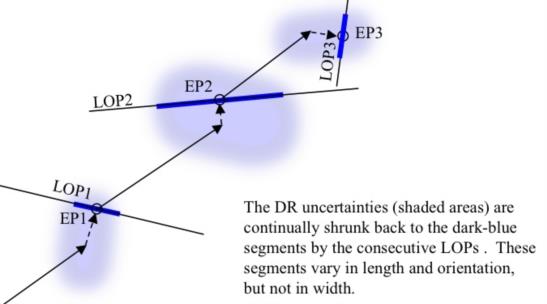
NavList:
A Community Devoted to the Preservation and Practice of Celestial Navigation and Other Methods of Traditional Wayfinding
Eprf Vs, Trf
From: John Karl
Date: 2009 Dec 20, 13:14 -0600
From: John Karl
Date: 2009 Dec 20, 13:14 -0600
Geoffrey & Others, yes the shaded areas of uncertainty can be quite different from run to run, in size, shape, and orientation. This is perhaps better shown in the figure below. Note how the orientation of the long axis of these areas follows that of the previous LOP. The size can vary because of run length, and unusually variable winds, drift, heading changes, etc. The important point is the superior accuracy of the new LOP collapses this uncertainty to the dark blue line segment along the new LOP. The width of this segment is controlled by the LOP's accuracy, and its length by its extension across the DR uncertainty (the shaded area). Thus as a long run of fixes evolve, the various orientations of LOPs will limit the uncertainty in all directions. However yes indeed, if the LOPs all have the same direction, the uncertainty along that direction will continue to grow, but the uncertainty perpendicular to that LOP direction will maintain the LOP's accuracy. In practice, we usually have LOPs varying in direction from observation to observation. And the navigator should try to obtain such LOPs, whenever possible (as with the TRF). The shaded uncertainties surrounding the DRs are the max extend of realistic possibilities of DR error. Thus an EP can not fall outside of this area unless something is very wrong: that would dictate checking the LOP, knotmeter, compass, plotting, etc., etc. Of course the navigator must use his own judgment on whether the EP is unrealistically far off. So it seems that the EP running fix is superior to the traditional running fix because: (1) it never gives spurious results for small LOP crossing angles (2) is always closer to the EP than the TRF (3) allows for easier and better judgement calls on navigation errors (4) gives the same result as the TRF for sufficiently small crossing angles (5) is easier to plot. These comparisons with the traditional RFIX arise from the explicit assumptions it uses: that the estimated track component perpendicular to LOP1 is accurate and that component of estimated track parallel to LOP1 is completely useless. I've yet to hear a justification for these weird assumptions. JK -- NavList message boards: www.fer3.com/arc Or post by email to: NavList@fer3.com To , email NavList+@fer3.com







